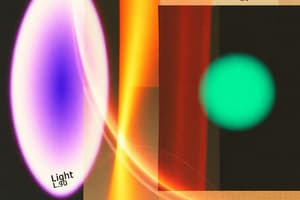Podcast
Questions and Answers
What is the order of the electromagnetic spectrum from highest to lowest frequency?
What is the order of the electromagnetic spectrum from highest to lowest frequency?
- Radio waves, Microwaves, Infrared, Visible light, Ultraviolet, X-rays, Gamma rays
- Visible light, Ultraviolet, X-rays, Gamma rays, Radio waves, Microwaves, Infrared
- Gamma rays, X-rays, Ultraviolet, Visible light, Infrared, Microwaves, Radio waves (correct)
- Ultraviolet, X-rays, Gamma rays, Infrared, Microwaves, Radio waves, Visible light
Which statement correctly describes the properties of radio waves?
Which statement correctly describes the properties of radio waves?
- Radio waves are only used for satellite communications.
- Radio waves are used for communication signals like TV and radio. (correct)
- Radio waves have a frequency higher than visible light.
- Radio waves have the shortest wavelength and highest energy.
How do ultraviolet (UV) rays impact human health?
How do ultraviolet (UV) rays impact human health?
- UV rays have no significant effects on human health.
- UV rays are primarily used in medical imaging with no harmful effects.
- UV rays can help produce vitamin D but also cause sunburns. (correct)
- UV rays can only cause sunburns without any benefits.
What is the primary application of X-rays in medicine?
What is the primary application of X-rays in medicine?
Which EM wave is known for having the shortest wavelength and highest energy?
Which EM wave is known for having the shortest wavelength and highest energy?
What physical property of waves is related to the energy carried by the wave?
What physical property of waves is related to the energy carried by the wave?
Which of the following best explains how a prism separates white light into different colors?
Which of the following best explains how a prism separates white light into different colors?
What is the name given to light that is visible to the human eye?
What is the name given to light that is visible to the human eye?
What determines the specific color that we perceive light to be?
What determines the specific color that we perceive light to be?
Which of the following colors of light corresponds to the shortest wavelength?
Which of the following colors of light corresponds to the shortest wavelength?
What distinguishes light from other types of waves such as sound and water waves?
What distinguishes light from other types of waves such as sound and water waves?
What forms electromagnetic waves according to the content provided?
What forms electromagnetic waves according to the content provided?
Which of the following correctly describes the relationship between wavelength, frequency, and energy in electromagnetic waves?
Which of the following correctly describes the relationship between wavelength, frequency, and energy in electromagnetic waves?
What is an essential feature of electromagnetic waves as described in the content?
What is an essential feature of electromagnetic waves as described in the content?
What is a practical application of understanding the electromagnetic spectrum mentioned in the content?
What is a practical application of understanding the electromagnetic spectrum mentioned in the content?
Flashcards
Electromagnetic Spectrum
Electromagnetic Spectrum
A range of waves (like light) with different frequencies and energies.
Radio Waves
Radio Waves
Lowest energy EM waves, used for communication (TV, radio, cell phones).
Visible Light
Visible Light
The part of the EM spectrum that our eyes can see (ROYGBIV).
Energy & Frequency in EM Waves
Energy & Frequency in EM Waves
Signup and view all the flashcards
X-Rays
X-Rays
Signup and view all the flashcards
Light as an EM wave
Light as an EM wave
Signup and view all the flashcards
Electromagnetic waves
Electromagnetic waves
Signup and view all the flashcards
EM wave formation
EM wave formation
Signup and view all the flashcards
Wavelength, frequency, and energy relationship
Wavelength, frequency, and energy relationship
Signup and view all the flashcards
Wavelength
Wavelength
Signup and view all the flashcards
Frequency
Frequency
Signup and view all the flashcards
Color Spectrum
Color Spectrum
Signup and view all the flashcards
Light wave and color
Light wave and color
Signup and view all the flashcards
Study Notes
Day 1: Lesson 3: Light Waves
- Objectives: define light, describe light waves as electromagnetic waves, explain the stages of EM wave formation, design a 3D model of EM waves
- Essential Question: What is light?
- Vocabulary: light, electromagnetic waves, radiation
The Nature of Light
- Light is a type of energy that travels as a wave
- Sources of light include light bulbs, burning logs, candles, fireflies, and some fish
- Light is different from other waves (like sound or water waves); it does not require a medium to travel
- Light is an electromagnetic (EM) wave
- EM waves are made of electric and magnetic fields
What patterns do you observe? How are the two waves similar? How are they different?
- Observe examples of transverse waves
- Consider how each transfers energy from one place to another
- Contrast mechanical waves to light waves
Electromagnetic Wave
- Diagram showing electric and magnetic fields
- EM waves are formed when electrically charged particles vibrate, disturbing the electric and magnetic fields around them
The stages (Electric and Magnetic fields) forming EM waves
- Electrically charged particles vibrating creates disturbances in the electric and magnetic fields
- These disturbances produce EM waves
- The electric and magnetic fields are perpendicular to each other
- The fields carry energy away from the charged particles
Group Activity: Design 3D model of EM waves
- Materials: scissors, hard papers, colored markers, ruler
- Instructions:
- Draw two or three waves on each paper using different colors to represent magnetic and electric waves
- All waves should be the same length (1 cm)
- Cut half the papers from one side along with the rest position of each wave, but do not split
- Cross the waves perpendicularly
- Ensure the waves are connected and oscillating
Day 2: Lesson 3: Light waves
- Objectives: identify different waves in the electromagnetic spectrum, explain the relationship between wavelength, frequency, and energy, compare and contrast different EM waves, relate the EM spectrum to everyday life and modern technology
- Essential Question: What is light?
EM spectrum
- The EM spectrum is a range of waves with different frequencies and energies
- Different types of EM waves have various uses (communication to medical treatments)
Starter
- Draw an EM wave (light wave) in your notebook showing the electric and magnetic fields
From the video:
- How do radio waves help with communication?
- Why is visible light essential for life on Earth?
- How can ultraviolet light both help (vitamin D) and harm (sunburn)?
- How do X-rays help doctors?
EM spectrum from lowest energy to highest
- Radio Waves: longest wavelength, lowest frequency and energy (TV, radio, cell phones)
- Microwaves: shorter than radio waves, used for ovens and satellite communication
- Infrared (IR) Radiation: just below visible light in frequency, used for heat lamps and night vision goggles
- Visible Light: the only part we can see with our eyes, colours in the rainbow (ROYGBIV)
- Ultraviolet (UV) Radiation: higher frequency than visible light, used for sterilization, sunburns
- X-rays: higher energy than UV, used in medical imaging (X-rays)
- Gamma rays: shortest wavelength, highest energy, used in cancer treatment, emitted by radioactive materials
Check your understanding
- Compare and contrast different EM waves and relate them to everyday life and modern technology
- Provide at least one use for two types of waves
DAY 3 - LESSON 2: LIGHT WAVES AND COLOR
- Standards:
- MS-PS4-1: Use mathematical representations to describe a simple model for waves that includes how the amplitude of waves is related to the energy in a wave
- MS-PS4-2: Develop and use a model to describe that waves are reflected, absorbed, or transmitted through various materials
Objectives
- State that color corresponds to certain wavelength and frequency of light
- Describe the light colors in a rainbow
- Explain why the rainbow colors are always in the same order
- Compare how different colors of light waves are arranged
Vocabulary
- Color
- White light
- Visible light
Groupwork (Research Skills)
- Instructions:
- Sit in a group
- Choose a role
- Search for information
- Present the information
- Questions:
- What is visible light?
- How is visible light separated into many colors?
- What separates white color into different colors?
Light travels as a wave
- Light travels as a wave, invisible because its wavelength is too short or long for human eyes
- Visible light is the part of light sensed by human eyes
- Visible light is a continuous range of wavelengths or frequencies
- Different colors correspond to different wavelengths and frequencies of light
Light traveling through prism
- The glass prism refracts white light differently
- Different colors bend different amounts during refraction.
- Which color bends more than others? (Violet)
Think-Pair-Share
- Correct order of visible light colors (ascending by wavelength)
What determines the color of light?
- Sunlight contains all visible light wavelengths.
- Wavelength and frequency of visible light determine its color
- Questions: Which light colors are in the shorter wavelength and which are in the longer wavelength?
CHECK YOUR UNDERSTANDING
- Color corresponds to certain wavelength and frequency of light
- Answer wavelength and frequency
Color is the perceptual of quality of light
- What can you say about the colour of light and their respective frequency?
Studying That Suits You
Use AI to generate personalized quizzes and flashcards to suit your learning preferences.




